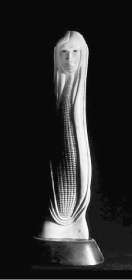One-Tank Trip/Iroquois Indian Museum, Howes
Cave
Iroquois sculptor Stan Hill inspires
exhibit
By KAREN BJORNL
Special to The News
9/5/2004
 |
He never imagined that he would be an artist. He never dreamed that his hobby, carving the bones of animals in his Grand Island home, would bring him fame and fortune.
"It seems like something takes over you - your whole being - it's not you anymore - what you see is what the Creator wants," Hill once said, trying to explain it.
Stanley R. Hill, an internationally exhibited Iroquois sculptor from Western New York, died last year at age 82, leaving behind three decades of artwork inspired by his Indian ancestors. The Iroquois Indian Museum in Howes Cave, a 41/2-hour drive from Buffalo, is honoring the man and his vision with "Stan Hill: An Inspiration." The exhibit displays his finest work, from small, decorative hair combs of deer antler and sculptures made from the vertebrae of whales to a magnificent eagle created from a two-foot-long caribou antler.
"It's very special. This is not 30 years of work, it's 30 years of love," says museum educator Mike Tarbell. "Spiritually, this is him."
Organized with the help of Rick Hill, the artist's son, there are hundreds of carvings in glass cases, photographs of Hill enlarged to wall-size and quotes from the artist, many from an interview that aired on ABC-TV in the 1980s.
"We have the largest collection of Iroquois artwork in the world. Stan is one of those people who made it possible," Tarbell says.
Besides Iroquois art, visitors see archaeological artifacts and learn about Iroquois history.
Visitors are surrounded by carvings of animals, trees and female spirits important to the Iroquois. There are many images of the turtle, central to the Iroquois story of creation, and the eagle, guardian of the evergreen tree that symbolizes the Six Nations of the Iroquois: Mohawk, Oneida, Onondaga, Cayuga, Seneca and Tuscarora.
While each piece is carved from antler bone, mostly deer and moose, each is unique.
Some of the most hauntingly exquisite works are sculptures of the Three Sisters, the life-giving symbols for corn, squash and beans, traditional Indian foods.
Hill was born Nov. 16, 1921 on a farm at the Six Nations Reserve in Ohsweken, Ont. His father, who liked to carve wooden boxes and clocks, was a Tuscarora. His mother, a quilter, was Mohawk. Because Iroquois adopt the tribe of their mother, Stan considered himself Mohawk.
At age 13, Hill left Six Nations and worked as a farm laborer in Niagara County. By the time he was 19, Hill was punching the clock at Bethlehem Steel Company as an apprentice in structural steel work.
World War II interrupted that job, and Hill served in the Navy as a metal smith and a deep-sea diver, repairing damaged battleships in the South Pacific.
After the war, when he was only 23, Buffalo Structural Steel made him a foreman. He settled into family life, raising a daughter and four sons with Alma Wilson, his Tuscarora wife. Eventually, Hill owned his own business, Consolidated Steel Erectors.
In 1971, Jim, his 21-year-old son, was killed in a car accident. Deeply grieving, Hill went mountain climbing in Alaska and saw an eagle for the first time.
"It transformed him," his son, Rick, recalled.
After 30 years, Hill lost interest in ironwork and started to carve antlers and bones.
"It started as a hobby, but gave him the time to think, to reflect and to question all of his previously held notions about life," Rick writes in the exhibit catalog.
At age 55, Hill began a new life. He left ironwork behind, determined to support his family as a full-time artist. In his home workshop, he cut and polished the animal bone supplied by hunters and others who find the shed antlers in the woods. Using different drill bits, Hill worked on the intricate details, operating the motors with foot controls to keep both hands on the piece.
Carving connected Hill to the spiritual world, the abode of his ancestors and the son he lost, his family and friends say.
Hill made simple pieces, like keychains and necklaces, which he sold at festivals and pow-wows, and fine artworks that cost thousands of dollars.
He won more than 50 awards at art shows around the country, including the Northern Arts and Crafts Show in Buffalo, and his sculpture is in collections at a dozen museums, including the Canadian Museum of Civilization in Ottawa, Royal Ontario Museum in Toronto, the Fenimore Art Museum in Cooperstown, Rochester Museum and Science Center and Bolle Museum in France.
Rick Hill says that one of his father's favorite saysing was "Life without struggles is no life."
"With each setback, he learned more about himself. With each success, he grew more thankful. With each carving, he grew more sensitive to the ways of his ancestors - he wanted us to realize that all of creation is sacred and meant to be celebrated because life is all too fleeting."
Mapping it out
Exhibit: "Stan Hill: An Inspiration" runs through
Oct. 31.
Nature Park: Guided and self-guided tours on short and long
trails winding through 45 acres of woods and meadows. Two 19th-century log
homes moved from Six Nations Reserve, Ont., can be found here.
Children's Museum: On the lower level of the museum, a turtle pond
and hands-on crafts and games teach about Iroquois culture and connections
to nature.
Hours: 10 a.m. to 5 p.m. Tuesday through Saturday and noon to 5 p.m. on Sunday.
Admission: $7 adults; $5.50 seniors; $4 children 5 to 12; and free for younger kids.
Information: (518) 296-8949, www.iroquoismuseum.org; www.schohariechamber.com, (800) 41-VISIT
Nearby: Howes Caverns www.howecaverns.com) is minutes away on the same road as the museum. Cooperstown is less than an hour away.